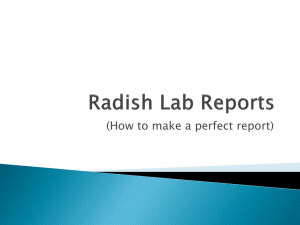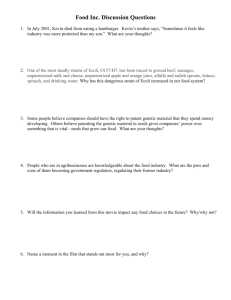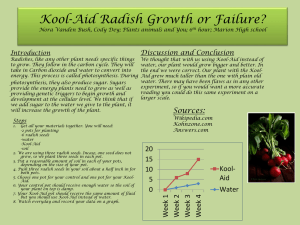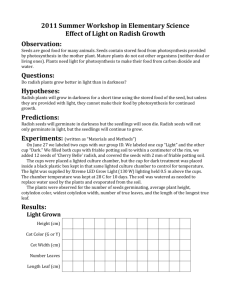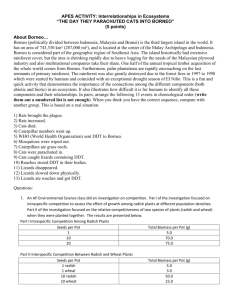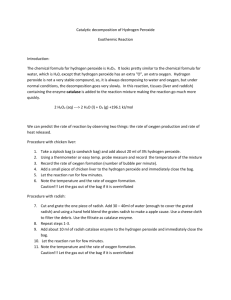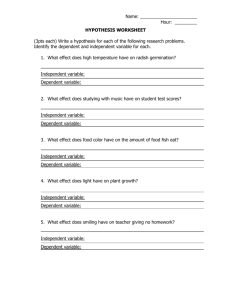research opinions in animal & veterinary sciences
advertisement
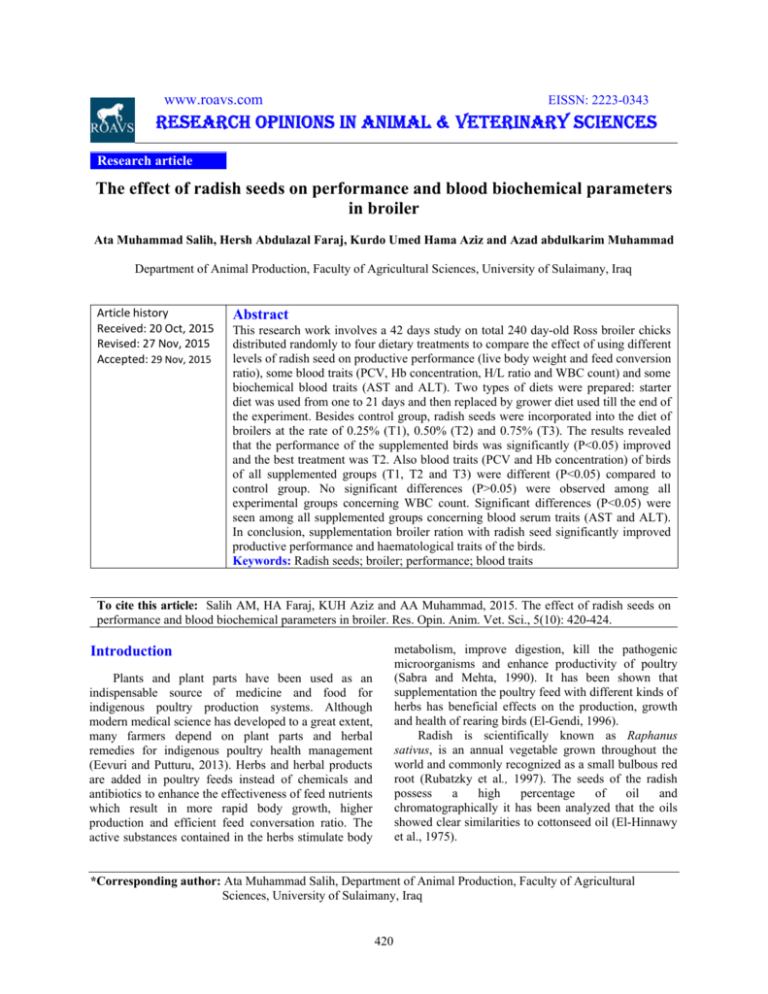
www.roavs.com EISSN: 2223-0343 RESEARCH OPINIONS IN ANIMAL & VETERINARY SCIENCES Research article The effect of radish seeds on performance and blood biochemical parameters in broiler Ata Muhammad Salih, Hersh Abdulazal Faraj, Kurdo Umed Hama Aziz and Azad abdulkarim Muhammad Department of Animal Production, Faculty of Agricultural Sciences, University of Sulaimany, Iraq Article history Received: 20 Oct, 2015 Revised: 27 Nov, 2015 Accepted: 29 Nov, 2015 Abstract This research work involves a 42 days study on total 240 day-old Ross broiler chicks distributed randomly to four dietary treatments to compare the effect of using different levels of radish seed on productive performance (live body weight and feed conversion ratio), some blood traits (PCV, Hb concentration, H/L ratio and WBC count) and some biochemical blood traits (AST and ALT). Two types of diets were prepared: starter diet was used from one to 21 days and then replaced by grower diet used till the end of the experiment. Besides control group, radish seeds were incorporated into the diet of broilers at the rate of 0.25% (T1), 0.50% (T2) and 0.75% (T3). The results revealed that the performance of the supplemented birds was significantly (P<0.05) improved and the best treatment was T2. Also blood traits (PCV and Hb concentration) of birds of all supplemented groups (T1, T2 and T3) were different (P<0.05) compared to control group. No significant differences (P>0.05) were observed among all experimental groups concerning WBC count. Significant differences (P<0.05) were seen among all supplemented groups concerning blood serum traits (AST and ALT). In conclusion, supplementation broiler ration with radish seed significantly improved productive performance and haematological traits of the birds. Keywords: Radish seeds; broiler; performance; blood traits To cite this article: Salih AM, HA Faraj, KUH Aziz and AA Muhammad, 2015. The effect of radish seeds on performance and blood biochemical parameters in broiler. Res. Opin. Anim. Vet. Sci., 5(10): 420-424. metabolism, improve digestion, kill the pathogenic microorganisms and enhance productivity of poultry (Sabra and Mehta, 1990). It has been shown that supplementation the poultry feed with different kinds of herbs has beneficial effects on the production, growth and health of rearing birds (El-Gendi, 1996). Radish is scientifically known as Raphanus sativus, is an annual vegetable grown throughout the world and commonly recognized as a small bulbous red root (Rubatzky et al., 1997). The seeds of the radish possess a high percentage of oil and chromatographically it has been analyzed that the oils showed clear similarities to cottonseed oil (El-Hinnawy et al., 1975). Introduction Plants and plant parts have been used as an indispensable source of medicine and food for indigenous poultry production systems. Although modern medical science has developed to a great extent, many farmers depend on plant parts and herbal remedies for indigenous poultry health management (Eevuri and Putturu, 2013). Herbs and herbal products are added in poultry feeds instead of chemicals and antibiotics to enhance the effectiveness of feed nutrients which result in more rapid body growth, higher production and efficient feed conversation ratio. The active substances contained in the herbs stimulate body *Corresponding author: Ata Muhammad Salih, Department of Animal Production, Faculty of Agricultural Sciences, University of Sulaimany, Iraq 420 Res. Opin. Anim. Vet. Sci., 2015, 5(10): 420-424. Major fatty acids in radish are linolenic acid (52-55%) followed by erucic acid (30-33%) and palmitic acid (2022%) (Seiichiro et al., 1984). Radish seed is rich in vitamin C content. In addition, it also contains vitamin B6, fiber, folate, and minerals like potassium, calcium, magnesium and iodine. Past studies in human show some evidences that radish supports liver health (Popovic et al., 1993), and it has been reported that radish is essential for inhibition of platelet aggregation (Kasjanovova and Macejka, 1992). Raphanin is a substance found in radish seeds are involved in the thyroid hormone production (Duke, 1997). To our knowledge, there is rare information available in literature on the effect of radish seed on the performance and physiological status of broiler when added as a feed additive, therefore, our aim of this study was to evaluate the effects of supplementing broiler diet with radish seed on the performance of broiler. (5 birds) as a group per replicate with the help of electronic balance. From the second week, birds were individually weighed for each group and respective productive traits were calculated. Blood samples were taken during week 2, 4 and 6 of the experiment from the wing vein in pair. One pair of blood samples was used for determination of packed cell volume (PCV), haemoglobin concentration (Hb), heterophil to lymphocyte ratio (H/L) and WBC count. The second pair of blood samples was used for determination of Aspartate transaminase (AST) and alanine aminotransferase (ALT) after centrifugation at 1500 rpm for 10 minutes. Data were subjected to one-way analysis of variance using XLStat, version 7.5, 2004. The significant difference between the means of traits was determined using Duncan's multiple range test (Duncan, 1955). P value less than 0.05 was statistically considered significant. Materials and Methods Results A total 240 day-old, broiler chicks (Ross 308) were raised on sawdust with the thickness of 5cm as litter at poultry experimental fields of Bakrajo, Faculty of Agricultural Sciences, University of Sulaimany. Broilers were provided with a continuous light throughout the study. The chicks were randomly assigned to four treatments (4 replicates for each group and 15 chicks per replicate). The experiment period lasted for six weeks. Birds were provided feed and water through plastic hanging feeders and drinkers during the experiment. The feed was prepared according to NRC (1994) for two phases: During starter phase chicks were provided a ration containing 22% CP and 3045 ME Kcal/kg and a grower diet composed of 20.15% CP and 3150 ME/kg diet. One group served as a control (without any supplementation) and the other groups were supplemented radish seeds at the rate of 0.25 (T1), 0.5 (T2) and 0.75% (T3). The results shown in Table 1 indicate that there is no significant difference existed in live body weight between the control and the treated groups during the first four weeks of the experiment. In the 5th and 6th weeks, T2 showed significantly higher (P<0.05) body weight as compared to control group. Similarly, better FCR was found in T2 compared to control and other treatment groups during 5th and 6th weeks of experiment (Table 2). As shown in Table 3, PCV and Hb increased significantly (P<0.05) during 4th and 6th weeks of the experiment in T2 and T3. H/L ratio decreased significantly P<0.05) in T3 during 4th and 6th weeks of the experiment (Table 3). Results of WBC, AST and ALT are shown in Table 4. WBC count was not affected by the treatments, however, AST decreased significantly (P<0.05) in treated groups during the 2nd and 6th weeks while in 4th week, it decreased significantly (P<0.05) in T1 and T3. ALT decreased significantly (P<0.05) in the treated groups during the 2nd, 4th and 6th weeks of the experiment. Measurements and determinations The chicks were weight individually at one day old age and then weighed at the beginning of the first week Table 1: Effect of dietary supplementation of on live body weight (g) (Mean±SE) of broiler chicken at different weeks of age Treatments Weeks 1 2 3 4 5 6 C 124.300±5.21 321.560±8.19 765.20±19.41 1015.82±34.61 1557.90±40.46b 2130.33±64.33b T1 118.920±3.59 325.360±6.91 768.00 ±25.65 1021.10±33.89 1560.00±56.49b 2133.33±63.26b a 2360.33±71.74a T2 116.160±4.60 320.920±8.41 780.00±35.4 1111.00±48.53 1680.00±56.52 b T3 115.840 ±5.92 321.980±7.83 777.00±23.17 1088.00±49.76 1562.50±63.84 2175.00±77.40b C: control group; T1, T2 and T3: adding radish seeds to the diet of broiler chicken at levels of 0.25, 0.50 and 0.75% respectively. a, b : Values within columns followed by different letters differ significantly (P<0.05) 421 Res. Opin. Anim. Vet. Sci., 2015, 5(10): 420-424. Table 2: Effect of dietary supplementation of on feed conversion ratio (Mean±SE) of broiler chicken at different weeks of age Treatments Weeks 1 2 3 4 5 6 Accumulative FCR C 1.085±0.064 1.361±0.072 1.645±0.054 1.920±0.037 2.034±0.080a 2.200±0.086a 1.7075±0.12a T1 1.084±0.048 1.365±0.078 1.660±0.076 1.908±0.026 2.024±0.074a 2.179±0.11a 1.7033±0.15a b b 1.950±0.112 1.633±0.25a T2 1.082±0.064 1.348±0.065 1.608±0.181 1.890±0.028 1.920±0.070 a a T3 1.083±0.054 1.377±0.080 1.650±0.140 1.889±0.09 2.023±0.091 2.156±0.110 1.6963±0.27a C: control group; T1, T2 and T3: adding radish seeds to the diet of broiler chicken at levels of 0.25, 0.50 and 0.75% respectively. a, b : Values within columns followed by different letters differ significantly (P<0.05) Table 3: Effect of dietary supplementation of on PCV, Hb concentration and H/L ratio (Mean±SE) in broiler chickens at different weeks of age Treatments PCV (%) Hb (g/dl) H/L ratio Weeks Weeks Weeks 2 4 6 2 4 6 2 4 6 C 23.15±0.60 28.3±2.03c 29.9±1.99c 4.97±0.78 6.07±0.96c 9.99±1.10c 0.240±0.068 0.320±0.099a 0.410±0.101a T1 23.08±0.75 32.2±1.37b 33.8±1.90b 5.12±0.84 7.07±1.05b 11.12±1.03b 0.241±0.079 0.278±0.087b 0.316±0.110b T2 23.03±0.88 33±1.96a 36.5±1.64a 5.08±0.90 7.65±1.08a 12.18±1.19a 0.240±0.060 0.259±0.088b 0.304±0.099b T3 23.05±0.43 35±1.68a 36.8±1.77a 5.07±0.78 7.86±1.20a 12.20±0.99a 0.236±0.086 0.245±0.096c 0.276±0.096c C: control group; T1, T2 and T3: adding RD to the diet of broiler chicken at levels of 0.25, 0.50 and 0.75% respectively. a, b, c: Values within columns followed by different letters differ significantly (P<0.05) Table 4: Effect of dietary supplementation of Radish seed on WBC count and the activity of AST and ALT (Mean±SE) of broiler chickens at different weeks of age Treatments WBC (×103/µl) AST (U/l) ALT (U/l) Weeks Weeks Weeks 2 4 6 2 4 6 2 4 6 C 20.96±0.0922.85±0.15 24.76±0.13 132.4±6.34a 140.4±6.04a 140.4±9.03a 36.20±4.8a 36.00±6.8a 34.90±4.5a T1 21.08±0.1822.90±0.13 25.05±0.17 107.6±7.96b 122.6±9.96b 128.6±8.04b 26.20±8.2b 24.10±9.2b 23.70±5.5b T2 21.01±0.1122.90±0.13 25.06±0.16 102.0±9.03b 132.0±14.03a 126.0±6.01b 25.20±5.6b 24.00±3.6b 22.80±7.2b T3 21.02±0.1223.08±0.17 25.14±0.09 103.40±11.0b 123.40 ± 9.08b 120.2±6.09b 23.10±8.4b 22.11±6.4b 20.50±9.2b C: control group; T1, T2 and T3: adding RD to the diet of broiler chicken at levels of 0.25, 0.50 and 0.75% respectively; a,b Values within columns followed by different letters differ significantly (P<0.05). Discussion Concerning feed conversion ratio it is clear that adding up to 0.50% of radish seeds better feed conversion values was achieved. Such improvement may be attributed to the properties of those materials of radish seed that could act as an anti-bacterial, antiprotozoal and anti-fungal and antioxidants. Furthermore this enhancement of FCR may be due to flavonoids and essential oils, which had the beneficial effect or stimulation and activity of the digestive system (Bradley, 1992). In the present study, in addition to better performance, a significant increase in haematological traits (PCV and Hb) in groups fed diet supplemented with radish seeds may be due to the higher body weight in broilers. Since broiler with higher weight require more haemoglobin and the amount of blood flow to the muscles, or it may be due to the contents of some physiological important substances in radish seeds which modulate hormone production in the thyroid gland (Duke, 1997). Erythropoiesis which provides the necessary oxygen capacity of the blood and the control of erythropoiesis has always been closely linked to the In the present study, adding radish seed to the diet of broiler significantly improved the body weight and feed conversion ratio. It is due to the fact that radish seeds have important substances which support chickens for maximum growth. In nutritional and physiological research works, radish seed has been proven to have some physiological important substances which modulate hormone production in the thyroid gland (Duke, 1997) and radish is well reputed in the folkloric system of medicine for the treatment of gastrointestinal and cardiovascular disorders (Zaman, 2004). The improvement in the live body weight of birds fed radish seeds could be attributed to some of its nutritional content, which contains a reasonable amount of vitamins, minerals, oil, protein with little amount of crude fiber and promising sources of energy. These ingredients may be considered as a preliminary indication of their feeding values for broiler (Tohamy and el-kady, 2007). 422 Res. Opin. Anim. Vet. Sci., 2015, 5(10): 420-424. Bradley, PR (1992) British Herbal Compendium. Bournemouth: British Herbal Medicine Association. Vol 1, pp: 395–9. Brenner B, Fandrey J, Jelkmann W (1994) Serum immunoreactive erythropoietin in hyper-and hypothyroidism: clinical observations related to cell culture studies. Eur J Haematol 53: 6-10. Dame C, Fahnenstich H, Freitag P, Hofmann D, Abdul-Nour T, Bartmann P, Fandrey J (1998) Erythropoietin mRNA expression in human fetal and neonatal tissue. Blood 92: 3218-3225. Dufour D, Lott J, Nolte F, Gretch D (2000) Diagnoses and monitoring of hepatic injury. II Recommendation for use laboratory test of screening, diagnosis and monitoring. Clin Chem 46: 2050-2068. Duke JA (1997) The Green Pharmacy. Emmaus, PA: Rodale Press. Eevuri TR, Putturu R (2013) Use of certain herbal preparations in broiler feeds- A review, Vet World 6: 172-179. EL-Gendi GM (1996) Effect of feeding dietary herbal feed additives on productive and metabolic responses of broiler chicks. Egypt Poult Sci 16: 395-412. El-Hinnawy I, Barakat S, Fouad KR (1975) Biochemical studies on some oleaginous seeds of Cruciferae plants. Grasas Aceites 26: 147–149. El-Tohamy MM, El-Kady1 RI (2007) Partial Replacement of Soybean Meal with Some Medicinal Plant Seed Meals and their Effect on the Performance of Rabbits. Inter J Agric Biol 09–2– 215–219. Kasjanovova D, Macejka J (1992) The Effect of Extracts From Garden Radish and Horseradish on Platelet Functional Activity in vitro. Res Inst Gerontol 47: 876-877. Leshchinsky TV, Klasing, KC (2001) Relationship between the level of dietary vitamin E and the immune response of broiler chickens. Poult Sci 80: 1590–1599. NRC (National Research Council) (1994) Nutrient Requirements of Poultry, 9th rev edn, (Washington, DC, National Academy Press). Popovic M, Lukic V, Jakovljevic V, et al (1993) The Effect of the radish juice on liver function. Fitoterapia, 64: 229-231. Preeti S, Jaspal S (2013) Medicinal and therapeutic utilities of Raphanus sativus. Inter J Plant Anim Environm Sci 7: 2231-4490. Rubatzky, Vincent E, Yamaguchi, Mas (1997) World Vegetables: Principles, Production and Nutritive Values. New York: Chapman & Hall. Sabra, KL, Mehta, RK (1990) A Comparative study on additive of livol (Herbal growth promoter) and some chemical growth promoters in the diets of effects of thyroid hormones (Brenner et al., 1994). Adaptation to this increase metabolic demand is partly achieved by potent effects of thyroid hormone on erythropoiesis by a direct increase in the proliferation of erythroid progenitors (Dame et al., 1998). The increase in the blood flow provides greater flow of hormones, protein, carbohydrate and other essential nutrients to the muscles and therefore helps in the muscle growth. In this study, decreased H/L ratio could be explained by the role of active substances in radish seeds which enhance the immune status of the bird since the proportion of blood H/L is widely used to evaluate the presence of inflammation (Leshchinsky and Klasing, 2001). Radish seeds contain Sulphoraphene which is very potent for antibacterial activity against a variety of pathogenic bacteria including, streptococcus, Pyococcus, Pneumococcus and Escherichia coli. In addition, Raphanin, another sulphur containing oil obtained from radish seeds is very effective substance against Gram positive and Gram negative bacteria. The seeds of radish have also been reported to have a broad spectrum antibiotic, machrolysin which is very effective against Mycobacterium tuberculosis (Preeti and Jaspal, 2013). ALT is found in large concentration in the liver and small amount of this enzyme is also found in the heart, muscles and kidney, whereas, AST is found in many body tissues including the heart, muscle, kidney, brain and lung (Al-Daraji et al., 2008). The concentration of AST and ALT in the blood reflects the extent of the tissue damage (Dufour et al., 2000). Radish seed has a number of different but related functions. One of the most important functions is its role as an intracellular antioxidant (Xiaoling et al., 2001) and antitumor function (Akihiro et al., 1999). In this capacity, it prevents lipid peroxidation of polyunsaturated fatty acids within the cell. This could be the evidence of protecting cells and liver function by radish seeds (Popovic et al., 1993). Conclusion In conclusion, feeding, diet containing radish seed resulted in significant improvement in productive performance without negative effects on the physiological status of the body. References Akihiro M, Koji K, Hiroyoshi O, Kazuaki K, Yoshiko, A (1999) Antitumor substances from vegetables, their manufacture, and pharmaceutical compositions. Jpn Kokai Tokkyo Koho JP 49: 793. Al–Daraji HJ, Al-Hayani WK, Al–Hassani AS (2008) Avian Hematology. University of Higher Education and Scientific Research, University of Baghdad, College of Agriculture. 423 Res. Opin. Anim. Vet. Sci., 2015, 5(10): 420-424. broiler chickens. Ind J Anim Prod Mange 6: 115118. Seiichiro N, Kenjiro T, Ikuko N, Kayo M (1984) Lipids in vegetables. III. Variation of lipids and fatty acid composition in seed and growth stage of Chinese vegetable (part 2). Kenkyu Hokoku-Miyazaki Daigaku Nogakubu 31: 45–56. Xiaoling L, Dongxu C, Zesheng Z, Zhonghua L (2001) Study on antioxidative function of red radish pigment. Shipin Kexue 22: 19–21. Zaman, RU (2004) Study of cardioprotective activity of (Raphanus sativus L) in the rabbits. Pakistan J Biol Sci 7: 843–7. 424

